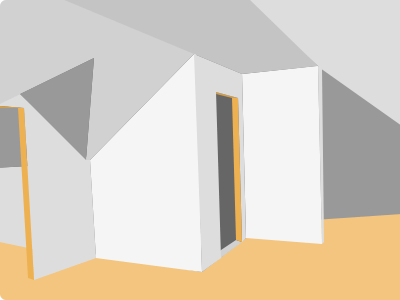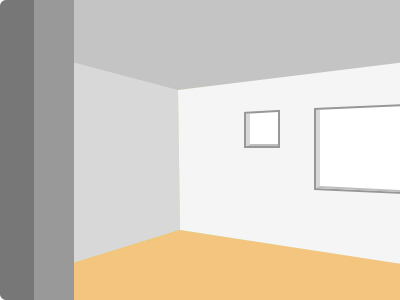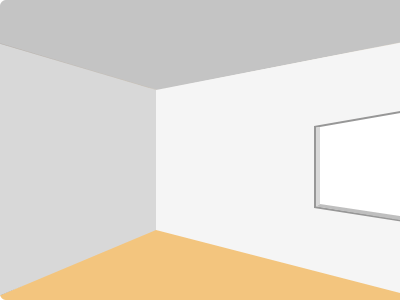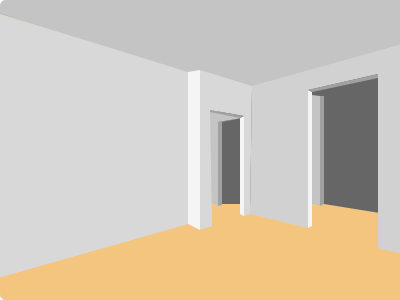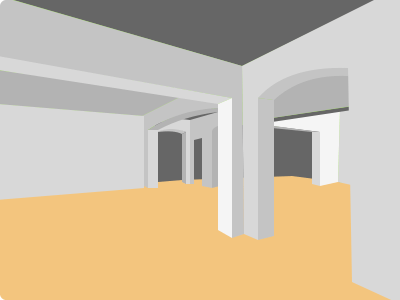Common Issues
There are pros and cons to every construction material. Drywall is fortunately easily repaired and tiny marks can be painted or plastered over.
- Settling cracks
- • A common issue with drywall and wood is simply the house settling. Over time, homes move just a tiny bit, which can cause little cracks or gaps in construction material, especially in climates with heat and cool temperature differences throughout the years.
- Moisture damage
- • The moisture itself isn't the real issue, it's what the moisture causes that becomes a concern. Mold is a very serious problem for homeowners. Mold grows quickly when present on drywall (4). This is true for small problems or even flooding damage, and must be addressed quickly.
- Normal wear and tear
- • It's completely natural over the years for drywall to simply become chipped, dented, cracked, and peeling. That's a completely common issue and to be expected in a typical home. Having it repaired is a simple cost of homeownership.
- Invasive insects
- • Unfortunately nature can attempt to intrude on your home. This is in the form of termites, ants, and sometimes even cockroaches. To combat this, an exterminator is needed, and then to fix the damages, a drywall repair specialist should be called in.
- Rodents
- • Much like insects, unfortunately small rodents also attempt to live in your home rent free. This can also similarly be addressed by hiring an exterminator, and then drywall repair for the damage. The total damage is relative to the amount of rodents.
- Drywall anchors
- • Some pictures and frames require the use of an anchor. While not wholly destructive, they can leave holes in your drywall that need to be plastered up. Worst case scenario is the unit failing and ripping out of your wall, taking some drywall with it.
- Accidents
- • One thing that can happen around the house are simply accidents that hit the drywall. A slight ding can occur when moderate force is used on the material, fortunately it can be easily plastered up.
- Mold
- • Often a byproduct of moisture, mold and mildew have a habit of creating health problems for homeowners. FEMA has stated that if your home has seen extensive moisture or flooding damage, mold can grow within 24 to 48 hours (5). So nip that health risk in the bud and contact a professional.
Back to top
Benefits
The reason drywall is so popular is because of the financial and material perks. Not only is it easy to work with, but it makes for a great construction material. Additionally it can benefit the homeowner in a number of ways.
Affordable
Drywall is hands down the most affordable material to wall up framework with. This makes it appealing to both contractors and homeowners. Prices are presented below.
Fire resistant
Because gypsum is naturally fire-resistant, drywall makes for a very safe material for home interiors, especially in case of a fire. Studies have shown that gypsum actually slows the spread of flame in case of a fire (6). So drywall isn't just an affordable choice, it also keeps your home safer.
Sound Dampening
Drywall also naturally dampens sound by a significant amount. Rooms aren't completely 100% soundproof, but it's certainly quieter. The material effectively "contains" sound within spaces (7). This is especially helpful in smaller homes with thin walls.
Commercial
Because there are so many benefits associated with drywall, gypsum makes for a very strong commercial building material as well. Being a cheap and reliable component that is easy to work with makes it very valuable to businesses looking to save money on construction costs. For a 200 sq. ft. installation job, the cost can be anywhere from $1,650 to $3,100. Drywalling tools are also included into the total price (8). The pricing breakdown for commercial work (200 sq. ft. lot) follows as such:
- • Labor: $350 - $1,500
- • Equipment: $50 - $75
- • Drywall sheets: $250 - $750
- • Other material costs (tape, plaster, nails...): $450 - $550
Back to top
Rooms
Anything with framework around it can potentially be a drywalled room. Most modern homes are furnished this way. The following rooms are where drywall is most commonly installed.
-
Attic
Attic ~ $1,000 to $2,350.
-
Bedroom
Bedroom ~ $490 to $800.
-
Bathroom
Bathroom ~ $500 to $3,000 (more if it was a leak).
-
Small room
Small room ~ $600 to $2,500.
-
Medium sized room
Medium sized room ~ $800 to $3,500.
-
Large room
Large room ~ $1,200 to $4,100.
Pricing
The final price tag is somewhat difficult to nail down until contractors can show up at the site and give an estimate. This is a very general list that only applies to material costs. To get a better understanding of how much a drywall project will cost, talk to a contractor and have them give you a quote on the site.
- • Generally $1.50 per sq. ft.
- • 4' by 8' board: $7
- • 4' by 12' board: $12
- • 4' by 14' board: $15
- • 4' by 16' board: $16
Back to top
Services
- Ceilings
- Ceiling repair is needed when you noticed stains, dripping, or dips in your ceiling. This is not only an indication that the plastering is needed but also could be a sign that there is an issue with your roofing.
- Wall
- Where drywall really shines is in walling. Standard modern home building techniques call for drywall to be put up around framework of a new home. And because it is so environmentally friendly, both the offices of the EPA and the U.S. Green Building Council use drywall in their offices (9).
- Windows
- The drywall around your windows is one of the most critical places to have proper insulation in your home. This is due to the fact that your windows essentially feep in or let our the air, causing the temperature of your home to be altered. In other words, windows can save you money on heating and cooling costs. So make sure the drywall around your windows is up to the task.
Back to top
References
- "Gypsum". Geology.com. Retrieved 30 June 2017
- "Gypsum". Minerals Education. Retrieved 30 June 2017
- "Gypsum". Minerals.gov. Retrieved 30 June 2017
- "A Brief Guide to Mold, Moisture and Your Home". EPA. Retrieved 30 June 2017
- "Dealing with Mold and Mildew in your Flood Damaged Home". FEMA. Retrieved 30 June 2017
- "Differences in DRYWALL". AWCI. Retrieved 30 June 2017
- "Design is More Than Great Aesthetic". USG. Retrieved 30 June 2017
- "Common drywall tools". Wikipedia. Retrieved 30 June 2017
- "What is Gypsum?". Gypsum Association. Retrieved 30 June 2017
Back to top
